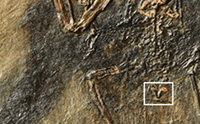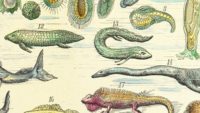By Frost Smith When we see Scripture refer to “invisible things” as being evidence for our Creator, do we often think of chemistry? …read more Source: AIG Daily
Research provides evidence that nuclear transmutation rates were dramatically higher in the past. …read more Source: creation.com
The bald eagle … a powerful, swift and independent creature. …read more Source: creation.com
Pacific salmon are more accurate than guided missiles when it is time to spawn. …read more Source: creation.com
About a dozen species of Darwin’s famous finches inhabit the various Galapagos Islands. Textbooks have long used these animals as examples of evolution. Now, a new finch species established itself as a bona fide population on the tiny island of Daphne Major. What do these new observations imply about textbook evolution? More… …read more Source: icr.org
Extraordinary claims about this extraordinary creature don’t always match what the science is revealing. …read more Source: creation.com
The ScienceBlogs website indicates intra-abdominal testicles show that elephants may have evolved from a common ancestor of manatees or whales. Many of us remember enjoying coloring books and can recall the connect-the-dot pictures. Looking back from an adult standpoint at what seemed like a fun activity as a kid, now I see an exercise that teaches a child in multiple ways. Having to identify the number one dot and use fine motor skills to draw the line from dot one to dot two and so on, you would continue drawing lines until you got to the last dot. This taught [More]
What does the Bible say about recent creation? How does science confirm Earth’s youth? ICR Science Writer Brian Thomas offers compelling confirmations of recent creation. Find confidence in the entirety of Scripture, encounter logical answers to the debate, and explore scientific evidence that confirms the Bible is right and its message is true. More… …read more Source: icr.org
By Dr. Kevin Anderson The presence of tissue, cells, and proteins remaining in dinosaur fossils poses a direct biochemical challenge to the standard geologic dating paradigm. …read more Source: AIG Daily
By David Woetzel Why should there be such “gratuitous beauty”? The plethora of extravagant biological characteristics prominently call out for an explanation. …read more Source: AIG Daily
The receptacle is ‘expertly crafted’ and ‘delicately made’, but the flowers in it are said to have come about by chance. …read more Source: creation.com
Twelve criteria to use to define where the Flood stops in the rock record. …read more Source: creation.com
A team of scientists claims to have found the “oldest polar forest on record from the southern polar region.” The trees were found in Antarctica’s Transantarctic Mountains and include a mix of evergreens, deciduous trees, and gingkoes. How old is this oldest polar forest? More… …read more Source: icr.org
Communication is key when it comes to deciphering some secrets. …read more Source: creation.com
Examining the abundance of variations within creatures after Noah’s Flood. …read more Source: creation.com
Secular astronomers recently described three bizarre discoveries that challenge mainstream ideas of an evolving universe: a planet that’s too big for its star, a distant “young” galaxy that shouldn’t look old, and an explosion that should have happened a long, long time ago. More… …read more Source: icr.org
Dozens of technical reports show original biochemistry in long-buried fossils, and the reports just keep coming. Three new reports give occasion to reconsider the age assignments for these fossils. The biochemicals they harbor resemble timers that should have elapsed long ago unless these fossils were deposited thousands of years ago, not millions. More… …read more Source: icr.org
How an icon of secular geology provides powerful evidence for Noah’s Flood. …read more Source: creation.com
Abstract The Sauk megasequence is thought to have been deposited during one of the highest sea level episodes of the Phanerozoic. However, few, if any, have examined the extent and volume of sediments deposited across entire continents in order to test the published, secular sea level curve against the rock record. This study examines the Lower Paleozoic sedimentary rocks across North America, South America, and Africa with particular attention given to the Sauk megasequence. Results show that the Sauk megasequence most likely represented a limited rise in global sea level. Africa and South America exhibit very little evidence of [More]
I saw a story in the news recently that reminded me of the tentative nature of historical science (the kind of science that is not directly testable, observable, and repeatable because it deals with the past) and how frequently the evolutionary story changes. Many fossil bones have been discovered covered in cuts and scrapes. Researchers thought this demonstrated that our supposed human ancestors (really just ape species) used tools to get the meat off. But a new study says the marks on the bones may have been made by crocodiles instead! Read More: Did Hominids or Crocodiles Make Marks [More]
Why one atheist’s arguments about pandas don’t stand up to scrutiny. …read more Source: creation.com
Evidence of our Lord’s creativity and attention to detail can be seen throughout his creation, from the large to the very tiny, from the flashy to the drab. All you have to do is open your eyes and look. Here are two examples involving insects you’ve probably seen before but perhaps never thought much about: the water strider and the leafhopper. My, What Beautiful Legs You Have Water striders are a familiar sight on ponds and other bodies of water around the world. Belonging to the family Gerridae are 2,200 species of this insect that is commonly known [More]
Six years ago, a massive 9.0 earthquake rocked the island of Japan, but the worst was yet to come just hours later. Following the earthquake, a 125-foot tall tsunami decimated the Japanese coastline, killing 18,000 people, melting down three nuclear reactors, and washing 5 million tons of debris out to sea, including fishing boats, docks, buoys, and various pieces of wood and plastic. This debris was caught by ocean currents and slowly transported 4,000 miles to coastlines on the other side of the world, including Hawaii and the Pacific coast of North America. Tsunami Voyagers This tsunami debris [More]
Astonishing examples of high intelligence in “lower” animals point to an all-knowing Creator. Truman, an octopus at the New England Aquarium, could see several aquarium workers each day; but he consistently soaked only one college student volunteer with cold salty water. After taking a leave for a few months, the volunteer returned and was promptly soaked again. Truman did not soak anyone else in the interim.1 In the past decade, octopuses have gained a reputation for high intelligence and acute awareness of their environment. They don’t just recognize human helpers, but they plan ahead. Many species will construct [More]
The origin of marine reptiles like ichthyosaurs poses a dilemma for evolution. …read more Source: creation.com
By Dr. Danny R. Faulkner Promoters of Nibiru‘s existence often call it “Planet X,” and use articles and astronomers’ comments about Planet X to support their claims about Nibiru. …read more Source: AIG Daily
By Dr. Nathaniel T. Jeanson Darwin’s On the Origin of Species shook the scientific and religious understanding of the world that the ramifications have been felt to this day. …read more Source: AIG Daily
























![Recent Creation Confirmed [Podcast] Recent Creation Confirmed [Podcast]](http://proofthebibleistrue.com/wp-content/uploads/2017/12/85439-thumb-200x124.jpg)













